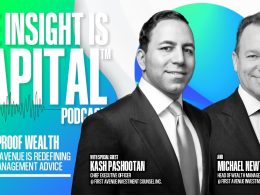by William Smead, Smead Capital Management
Dear fellow investors,
The other 490 stocks in the S&P 500 Index, which had not participated in this year’s “bull market,” woke up in reaction to what appears to be a capitulation in the political reality of ongoing inflation. The Federal Reserve Board Chairman admitted publicly what we felt all along. The chart below shows that there is still way too much money chasing too few goods:
Left unaddressed, ongoing inflation with no fiscal will to pull back from the monetization of $11 trillion in fiscal stimulus leaves the Fed in a vulnerable position. Either accept a deep recession (like Paul Volker did) or restore fiscal discipline by cutting government spending or aggressively raising taxes. Ultimately, inflating our way out of the mountain of federal debt now costing 4% interest remains the most likely outcome. This happened twice in the 1970s. Each time inflation pulled back, it was only temporary:
The problem is that stocks are not priced for any of these outcomes because of the financial euphoria created by years of declining interest rates. Here is how John Authers from Bloomberg quoted Howard Marks on the 17th of December:
He likes to ask people to nominate the single most important financial development of the past few decades. While popular candidates include the global financial crisis, the bursting of the tech bubble in 2000 or the desperate response to the Covid-19 pandemic in 2020, he says, “No one cites my candidate: the 2,000-basis-point decline in interest rates between 1980 and 2020. And yet that decline was probably responsible for the lion’s share of investment profits made over that period. How could it be overlooked?”
When rates are lower, repaying debt is easier, default is easier to avoid, and lenders have less need to worry about getting their money, while company managers escape tighter discipline from their creditors. It’s natural that there’s more debt. But it’s also generated new and more speculative forms of lending, such as the bonds issued when companies are bought by private equity groups. “I would venture that nearly 100% of capital for private equity investing has been put to work since interest rates began their downward move in 1980,” Marks says. “Should it come as a surprise that levered investing thrived in such salutary conditions?”
Which takes us to likely returns for the S&P 500 Index going forward. We’ve resisted the temptation in recent decades to pay much attention to the glass is half full view from Robert Schiller’s cyclically adjusted price/earnings ratio. However, in an era of inflation and a normalizing of interest rates, history is worthy of a look:
Putting this all together brings us to the following conclusion. First, the S&P 500 Index is likely to produce very poor inflation-adjusted returns for the next 10 to 15 years. Second, we believe money can be made in the shares of companies which benefit from inflation like oil and gas stocks. Third, the most common question we get is, “When does the incredible run end for the 10 stocks that have made most of the returns in the last ten years?” Our answer is that it doesn’t make any difference to us when it happens, because we won’t own them now or when they get their reckoning.
Warm regards,

William Smead
The information contained in this missive represents Smead Capital Management’s opinions, and should not be construed as personalized or individualized investment advice and are subject to change. Past performance is no guarantee of future results. Bill Smead, CIO, wrote this article. It should not be assumed that investing in any securities mentioned above will or will not be profitable. Portfolio composition is subject to change at any time and references to specific securities, industries and sectors in this letter are not recommendations to purchase or sell any particular security. Current and future portfolio holdings are subject to risk. In preparing this document, SCM has relied upon and assumed, without independent verification, the accuracy and completeness of all information available from public sources. A list of all recommendations made by Smead Capital Management within the past twelve-month period is available upon request.
©2023 Smead Capital Management, Inc. All rights reserved.
This Missive and others are available at www.smeadcap.com

















